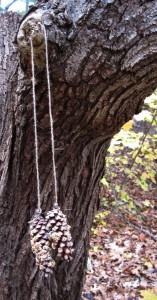By Kristen Swanberg, Senior Director of Education
This winter create a backyard bistro for the birds! Just by hanging a few feeders you can attract cardinals, chickadees, nuthatches, woodpeckers and more. Watch your backyard transform into a wildlife sanctuary.
Bird feeding is fun – but it also helps our feathered friends survive harsh winter conditions when food may be hard to find or buried under the deep snow.
Make Your Own Feeder
Use your imagination and create bird feeders with just a few household items. Here are two ideas to start with:
Milk Carton Bird Feeder
Materials:Â scissors, milk or juice carton, string, birdseed, chopsticks (or 10”-12” twigs), hole-punch, nail.
– Wash the carton and let it dry completely.
– Using the hole-punch, create a hole in the top edge of the carton. Then tie a string through this hole.
– With scissors, cut feeding holes two inches up from the bottom. Make the feeding holes two to three inches in diameter.
-Â Add perches by making a hole with the nail that chopsticks or twigs can fit through.
– Add the seed and hang it outside.
Pinecone Bird Feeder
Materials:Â Pinecones, string, peanut butter, birdseed, spoon, pie plate, scissors.
– Tie a long string to the top of your pine cone.
– Use a spoon to spread peanut butter all over your pinecone.
– Sprinkle birdseed of your choice in shallow pan and roll the cone covered in peanut butter in the seed so that the seeds stick to the peanut butter.
– Head outside and tie your pinecone feeder to a tree branch.
See Elyse Major’s how-to instructions: Make a simple pine cone bird feeder
Feeding Tips:
There are many types of birdseed to choose from and you will find that each bird species has a preference to the type of seed they eat. Black-oil sunflower seed is probably the most popular to attract cardinals, black-capped chickadees, white-breasted nuthatches, juncos and others. Other seed options include millet, cracked corn, and safflower seed. Try mixing different seeds together and see which mixture is preferred by the birds in your area.
Some birds like Juncos are “ground feeders” — so be sure to spread seed on the ground.
Once you put your feeder up make sure you keep it full all winter long as many birds will rely on it as a regular place to eat. You also want to keep it clean.
Other ways to attract a variety of birds is to put up a suet feeder, platform or tube feeders, and a bowl of ice-free water.
Bird Watching Tips:
Birds come in all shapes, sizes and colors. They have different calls and can be picky about what they eat. A field guide and binoculars will help you identify them. Why not keep a list of the birds you see and count them at the end of the winter?
Here is a list of things to look for when identifying birds:
– Size – Ask yourself, is the bird bigger or smaller than a robin?
– Markings – Look at the coloration of the feathers, what is unique? Does the bird have markings like a cap, a scarf or bib, eye streaks?
– Beak – What shape is the beak? Is it short and wide to crack seeds, is it long and narrow to eat suet, is it sharply curved as if to eat meat?
– Bird Legs – Are they short and narrow, long with webbed feet, or long with strong talons?
Sources:
http://www.dnr.state.wi.us/org/caer/ce/eek/nature/winterbird.htm
Discover Nature in Winter by Elizabeth P. Lawlor








